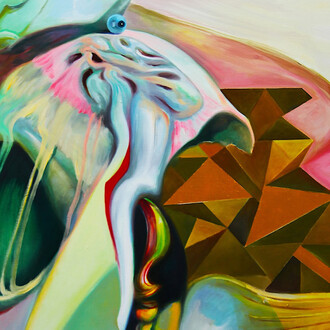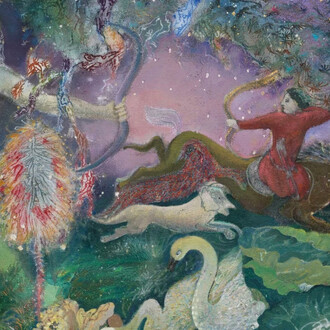Wild Things and perennials speaks to the enduring and calming influence of plants and nature amidst a tumultuous world.
(Nengi Omuku)
Kasmin is proud to present Nengi Omuku’s (b. 1987) first solo exhibition in New York, titled Wild things and perennials. This new body of eight oil paintings, each uniquely realized on the traditional Nigerian textile sanyan, develops Omuku’s vision of painting as a constant and sustaining force in a perpetually changing world. Nengi Omuku: Wild things and perennials coincides with the artist’s ongoing solo museum exhibition, The dance of people and the Natural world, at Arnolfini, Bristol, United Kingdom.
Omuku’s impressionistic landscapes and distinctive, rich color palettes provide enveloping spaces for the artist’s loosely rendered individual and group portraits. Blending interior and exterior, figure and ground, Omuku explores themes of refuge and stillness interwoven with personal narratives drawn from her recent experiences in Lagos, London, New York, and in residence at Civitella Ranieri, Italy. With works suspended from the ceiling, the installation activates the gallery architecture while offering viewers a space of reprieve from the motions of daily life.
Even when working with oils on sanyan, I’m aware that I’m bringing together western and West African heritage. I really enjoy being in the middle. It helps me have a broader view of the world.
(Nengi Omuku, as told to Frieze)
Throughout the exhibition, Omuku’s perennials include plants and flowers, spectacular skies, and figures from her community—fixtures that endure and renew through celebration and crisis alike. Realized during a period of upheaval in the artist’s life, when personal challenges including studio fires and flooding accompanied wider political unrest in her native Nigeria, Wild things and perennials underscores how the natural forces of the world can both instigate turmoil and offer reprieve.
The blooming of a garden, for example, offers a constant source of creative energy in this body of work. Herself a gardener, Omuku’s unique relationship to nature permeates through her compositions of human figures resting or floating among plant life, clouds, or the sea. In Orange bougainvillea, Omuku draws directly from her garden to abstractly render figures dancing among impressions of flowers that stem from the eponymous plant. In I can’t feel my legs 2, she applies layers of color to achieve a range of tones that blend figures to the landscape. Upon closer inspection, resulting bursts of color foreground a sense of harmony between people and the natural environment.
Elsewhere, the artist invokes an intimate gathering of friends in Small groups, situated where the built environment collapses into the natural landscape as an intricate red carpet reflects the warmth of the open sky above. Drawing a connection between human’s interdependence with each other and with the natural world, Omuku’s paintings attest to the imaginative power of reverie and empathy. In Waters covered the sea, a sky of purple clouds and crashing waves encroach upon a group of figures in the foreground, whose mixed reactions capture a scene of uncertainty as landscape flattens into broad strokes of brown paint. A recurring subject for Omuku is the social group—families and communities whose ambiguous presence suggests a contradiction. While we desire to gather and belong, we may also experience a sense of dislocation from our identity or society. Omuku brings forth such unspoken social and psychological realities, speaking to the stories of her subjects.
Omuku creates the impression of beautiful figuration distilled from some ethereal miasma of dreams.
(The New York Times)
Omuku’s unique practice interlaces traditions that honor both her personal history as well as her West African heritage. The works on view demonstrate Omuku’s signature use of oil paint over sanyan, an Aso oke fabric traditionally hand spun by the Yoruba people. Certain works, such as Orange Bougainvillea and How It Ends, are realized on vintage sanyan sourced by the artist. Others, including I can’t feel my legs 2 and Small groups, were realized on new fabric commissioned by Omuku for the exhibition in an effort to keep the weaving tradition alive. Exploring the historical significance of sanyan, Omuku increasingly perceives her practice as a conversation between her materials, touching on themes of gender and domesticity, national and ceremonial dress, and the endurance of indigenous culture against contemporary legacies of colonialism.
Wild things and perennials follows Omuku’s inclusion in the exhibition Dissolving Realms at Kasmin in 2022, earning her praise from New York Times critic John Vincler, who wrote: “Omuku creates the impression of beautiful figuration distilled from some ethereal miasma of dreams”.
This October at Frieze London, Kasmin and Pippy Houldsworth Gallery will co-present a solo booth of new works by Omuku, who was nominated by Yinka Shonibare CBE for the curated Artist-to-Artist sector.
Nengi Omuku lives and works between Lagos, Nigeria and London, United Kingdom. Her solo exhibition The Dance of the People and the Natural World at Hastings Contemporary and Arnolfini earned her the ACBMT and Arnolfini International Artist Residency Award in 2024. Forthcoming projects include The Poetics of Dimension, curated by Larry Ossei-Mensah, Institute of Contemporary Art San Francisco and the 15th Dakar Biennale. She participated in Aso oke: Prestige Cloth from Nigeria at the Saint Louis Art Museum in 2023. Omuku’s work has recently been acquired by the Baltimore Museum of Art, MD; Norton Museum of Art, West Palm Beach, FL and the Government Art Collection, United Kingdom.
















